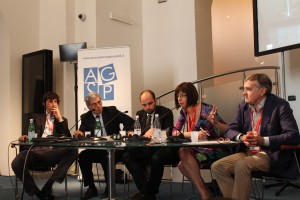It’s still going on
Between videos and opinions the panel called “The Arab Spring: an incomplete revolution” showed little bit of what an Arab Spring revolution represented for Middle East and the world. Many journalists were too close of the conflict as documentary-maker Itai Anghel. Anghel defends that to report the revolution the journalist should to be with people on the street. “We have to take the risk and feel the magnitude of the revolution in the dynamic on the street. They have a common enemy, the government”, said.
Francesca Caferri who works at La Repubblica, emphasize the citizen woman on Arab Spring. It’s reflects the woman participation in day-by-day life in Middle East. From 1999 to 2003 to number of work woman improve 20% and they represent more than 60% of Middle East population. “It’s not wasn’t a fight for women rights or freedom It was a fight to change the political situations as citizens”, complete.
The Arab Spring is also close to author and journalist Farid Adly. He born in Libya and specialized to cover the Arab Spring revolution and consequences and that country. There people didn’t support the government and it was corruption degraded. “That was a internal reason to do this revolution explode, nobody as expected and it’s impossible to imagine a conclusion”. The main reference of change was the democracy regime that “They didn’t know how it was, but they know that they had to try”, said.
Finally, the Il Sole 24 Ore journalist, Ugo Tramballi remanded that the movement is still going on and it’s going on without US and European countries influence. “In the first time Middle East felt tired to be controlled. The revolution de starts a important trend to destabilize those government and change the situation”, complete.

